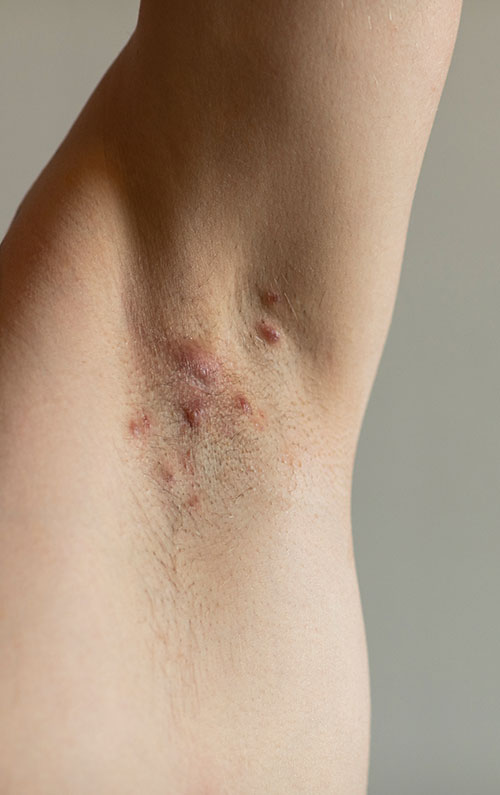Hidradenitis Suppurativa Awareness Week: Understanding, Managing, and Treating HS in Connecticut

Hidradenitis Suppurativa Awareness Week: Understanding, Managing, and Treating HS in Connecticut
Raising awareness, reducing stigma, and offering hope
Hidradenitis Suppurativa (HS) is a chronic, inflammatory skin condition that affects an estimated 1 in 100 people—yet it remains underdiagnosed and misunderstood. During Hidradenitis Suppurativa Awareness Week (June 1-7), we at Dermatology Physicians of Connecticut are committed to increasing public understanding and highlighting the best care options available for those living with HS.
What Is Hidradenitis Suppurativa?
HS often starts as small, painful bumps under the skin—commonly in areas where skin rubs together, such as the underarms, groin, buttocks, and under the breasts. These bumps may resemble pimples or ingrown hairs at first, which is why many patients overlook the early signs of hidradenitis suppurativa.
Over time, these lesions can worsen into deep nodules, abscesses, or draining tunnels under the skin. Scaring and flare-ups can significantly affect both physical comfort and emotional well-being.
Recognizing the Symptoms
Common Hidradenitis Suppurativa symptoms include:
- Painful lumps or boils
- Tunnels or sinus tracts under the skin
- Scarring or darkened patches from past flare-ups
- Unpleasant drainage or odor from inflamed areas
Learn more about how to diagnose hidradenitis suppurativa and when to seek help on our Hidradenitis Suppurativa information page.
What Causes HS Flare-Ups?
Hidradenitis suppurativa flare-up causes may vary, but common triggers include:
- Heat and sweat
- Friction from tight clothing
- Hormonal changes
- Smoking
- Diet and stress
Curious how warmer weather affects HS? Explore our previous blog on how heat and sun impact hidradenitis suppurativa in the summer.
Hidradenitis Suppurativa Treatments in CT
At DPCT, we offer a full spectrum of hidradenitis suppurativa treatment options in CT, personalized to each patient’s needs. Whether you’re newly diagnosed or have been living with HS for years, we’re here to help you manage symptoms and prevent flare-ups.
Treatment approaches include:
- Medications
We may prescribe hidradenitis suppurativa medication such as antibiotics, hormonal therapy, or biologics for hidradenitis suppurativa in CT to reduce inflammation and target underlying causes.
- In-Office Procedures
For select patients, hidradenitis suppurativa laser treatment in CT (like Nd:YAG laser therapy) can help reduce hair growth and inflammation in affected areas.
- Surgical Options
In severe cases, surgical treatment for hidradenitis suppurativa in Connecticut may be necessary to remove damaged tissue or chronic sinus tracts.
- Wound Care
Our team also specializes in hidradenitis suppurativa wound care in CT, providing expert support for dressing changes, infection prevention, and long-term skin health.
Frequently Asked Questions
- Is there a hidradenitis suppurativa specialist in CT?
Yes! At DPCT, our board-certified dermatologists offer specialized hidradenitis suppurativa care in Connecticut. With experience in both medical and surgical dermatology, we work closely with each patient to design the most effective care plan. - Can you show me hidradenitis suppurativa pictures?
If you’re looking for images to help identify potential symptoms, we encourage you to speak directly with your dermatologist. Visuals can be helpful for understanding what HS looks like, but a professional diagnosis is key. We’ve included a few sample images below to help illustrate common HS presentations.

Common sign of Hidradenitis Suppurativa
You’re Not Alone
Whether you’ve just noticed unusual skin changes or have been struggling for years, know that help is available. Finding a hidradenitis suppurativa specialist near me in CT is the first step toward better control and quality of life.
Schedule an appointment with one of our dermatologists today and take charge of your HS with expert support and compassionate care.
Dermatology Physicians of Connecticut is proud to provide comprehensive Hidradenitis Suppurativa treatment options, wound care, and personalized plans to patients across Fairfield County and beyond.
Convenient Locations Across Connecticut:
📍 Branford
📍 Fairfield
📍 Hamden
📍 New Haven
📍 New London
📍 Norwalk
📍 Oxford
📍 Shelton
📍 Stamford
📍 Woodbridge
📅 Book an appointment online or give our office a call at 203-538-5682 to schedule an appointment at a location near you!
